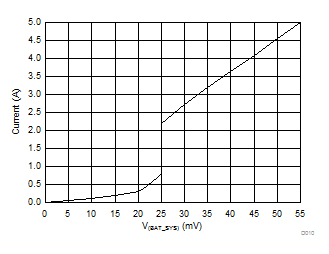ZHCSDI4D March 2015 – October 2022 BQ25890 , BQ25892
PRODUCTION DATA
- 1 特性
- 2 应用
- 3 说明
- 4 Revision History
- 5 说明(续)
- 6 Device Comparison Table
- 7 Pin Configuration and Functions
- 8 Specifications
-
9 Detailed Description
- 9.1 Functional Block Diagram
- 9.2
Feature Description
- 9.2.1 Device Power-On-Reset (POR)
- 9.2.2 Device Power Up from Battery without Input Source
- 9.2.3 Device Power Up from Input Source
- 9.2.4 Input Current Optimizer (ICO)
- 9.2.5 Boost Mode Operation from Battery
- 9.2.6 Power Path Management
- 9.2.7 Battery Charging Management
- 9.2.8 Battery Monitor
- 9.2.9 Status Outputs ( PG, STAT, and INT)
- 9.2.10 BATET (Q4) Control
- 9.2.11 Current Pulse Control Protocol
- 9.2.12 Input Current Limit on ILIM
- 9.2.13 Thermal Regulation and Thermal Shutdown
- 9.2.14 Voltage and Current Monitoring in Buck and Boost Mode
- 9.2.15 Battery Protection
- 9.2.16 Serial Interface
- 9.3 Device Functional Modes
- 9.4 Register Maps
- 10Application and Implementation
- 11Power Supply Recommendations
- 12Layout
- 13Device and Documentation Support
- 14Mechanical, Packaging, and Orderable Information
9.2.6.3 Supplement Mode
When the system voltage falls below the battery voltage, the BATFET turns on and the BATFET gate is regulated the gate drive of BATFET so that the minimum BATFET VDS stays at 30 mV when the current is low. This prevents oscillation from entering and exiting the Section 9.2.6.3. As the discharge current increases, the BATFET gate is regulated with a higher voltage to reduce RDS(ON) until the BATFET is in full conduction. At this point onwards, the BATFET VDS linearly increases with discharge current. Figure 9-4 shows the V-I curve of the BATFET gate regulation operation. BATFET turns off to exit Section 9.2.6.3 when the battery is below battery depletion threshold.
 Figure 9-4 BATFET V-I Curve
Figure 9-4 BATFET V-I Curve